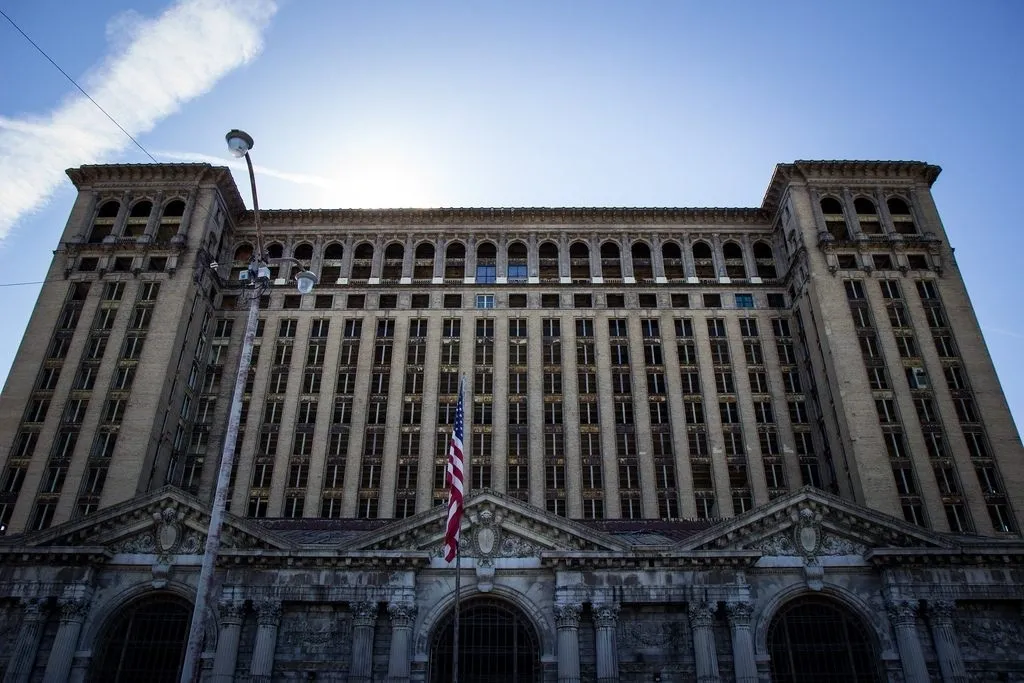A striking representation of Beaux-Arts architecture, soon to be revitalized as Ford‘s innovation campus. Michigan Central Station (MCS), often regarded as the most photographed abandoned structure in Detroit, has stood empty for over three decades.


Once a vibrant hub of activity, the now-deserted Michigan Central Station serves as a poignant reminder of Detroit’s economic challenges. Conceived in the early 20th century as part of the “City Beautiful” urban planning movement, which aimed to enrich urban landscapes with grand architectural landmarks, the station drew inspiration from Chicago’s 1894 World’s Columbian Exposition and its neoclassical White City.
Designed by the esteemed architectural firms of Warren & Wetmore from New York and Reed & Stem from St. Paul, Minnesota, the station was meant to rival the splendor of New York’s Grand Central Station. Originally slated for a grand opening in January 1914, fate intervened when a fire devastated the old city station on December 28, 1913. Remarkably, the new station opened a month earlier than planned, with only “a half hour’s notice,” as reported by local newspapers, showcasing its magnificent interior and impressive amenities.
Stretching across a vast area, the station not only accommodated tracks and passenger facilities but also offered an array of services including shops, lounges, restaurants, and a tower housing 500 offices for railroad business operations.


During its initial two decades, Michigan Central Station (MCS) shone as a symbol of civic pride, illustrating the promising future of the burgeoning city. Before World War II, the station flourished, bustling with the daily comings and goings of hundreds of trains. However, the mid-20th century brought a shift as rail travel declined, and by the 1950s, economic challenges loomed over the station.
The decline persisted, worsened by the bankruptcy of its parent railway company in 1968. The rise of automobile usage, particularly in Motor City, further diminished the appeal of rail travel. Despite efforts by Amtrak and the U.S. government to sustain the station through the 1970s, the mid-1980s saw a sharp decline, with only a few trains passing through the vast station.
On January 5, 1988, the last train departed from Michigan Central Station, marking the beginning of its second life as a poignant symbol of Detroit’s struggles. The building, open to both passersby and looters, bore witness to the city’s hardships until 1995 when a fence was finally erected, offering some protection against unauthorized entry.


Despite being designated on the National Register of Historic Places, the future of Michigan Central Station has remained uncertain. In April 2009, the Detroit city council controversially ordered the building’s demolition. However, strong opposition from hundreds of local residents and preservation organizations like the Michigan Central Station Preservation Society managed to halt the demolition plans. Nevertheless, as of now, there are no concrete plans in place for its preservation.
In June 2014, the station’s owners announced their intention to begin some rehabilitation efforts on the building, providing a glimmer of hope for its restoration. Then, in June 2018, a significant development occurred when Ford Motor Co. disclosed its acquisition of the building. Ford unveiled ambitious plans to not only restore the station but also rejuvenate the surrounding properties, envisioning them as an innovation campus by 2022. This announcement injected new energy into discussions about the future of Michigan Central Station, igniting anticipation and renewed optimism for its potential revival.






